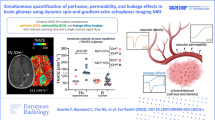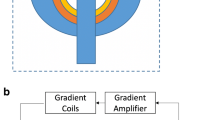Abstract
We used five MRI sequences in six patients with multiple sclerosis (MS): conventional spin-echo (CSE) with 5-mm slices; 2D fast spin-echo (FSE) with 2-mm slices; multishot T2*-weighted echo-planar imaging (EPI) with 5-mm slices; fast fluid-attenuated inversion recovery (fFLAIR) with 2-mm slices; and 3D fast spin-echo with 1.5-mm-thick slices. A total of 225 lesions were detected on CSE, 274 on 2D FSE, 137 on EPI, 385 on fFLAIR and 320 on 3D FSE. The EPI sequence was clearly the least sensitive and susceptibility artefact was a problem, particularly in the brain stem and temporal lobes. Fast FLAIR displayed a much higher number of supratentorial lesions (380) than 3D FSE (297), 2D FSE (264) or CSE (211). However, in the posterior cranial fossa 3D FSE was the most sensitive sequence (23 lesions), followed by CSE (14) and 2D FSE (10), while fFLAIR (5) was extremely insensitive.
Similar content being viewed by others
Author information
Authors and Affiliations
Additional information
Received: 6 January 1997 Accepted: 12 February 1997
Rights and permissions
About this article
Cite this article
Tubridy, N., Barker, G., MacManus, D. et al. Optimisation of unenhanced MRI for detection of lesions in multiple sclerosis: a comparison of five pulse sequences with variable slice thickness. Neuroradiology 40, 293–297 (1998). https://doi.org/10.1007/s002340050587
Issue Date:
DOI: https://doi.org/10.1007/s002340050587




